2017-02-18 By Robbin Laird
After the Norwegian Airpower Conference, 2017, I had a chance to talk with the head of the Norwegian Navy, Rear Admiral Lars Saunes.
Because this was an airpower conference, the focus on the maritime dimension naturally was primarily focused on air-sea integration in the extended defense of Norway.
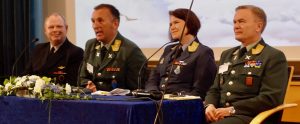 The Chiefs of Navy, the Joint Forces, the Air Force and Army, respectively at the Norwegian Airpower Conference, February 2017.
The Chiefs of Navy, the Joint Forces, the Air Force and Army, respectively at the Norwegian Airpower Conference, February 2017.
A key theme within the Conference was the re-emergence of Russia as an air and maritime power globally, and most certainly in the Northern region.
The Northern Fleet and the defense bastion built around the Kola Peninsula are two aspects of the direct presence of the Russians in the Norwegian area of interest.
And clearly, the expanded reach of Russia into the Arctic also affects the nature of the air and sea domain of strategic interest to Norway as well.
In the Long Term Plan issued on June 17, 2016, this is how the Ministry of Defence characterized the Russian challenge.
The most significant change in the Norwegian security environment is Russia’s growing military capability and its use of force. The military reform in Russia has resulted in a modernization of Russia’s conventional forces as well as a strengthening of its nuclear capabilities.
The Russian annexation of Crimea in 2014 and the continued destabilization of Eastern Ukraine both constitute violations of international law, which have had a dramatic effect on European security. Russia has repeatedly proven itself willing to use a wide range of measures, including military force, to sustain its political dominance and influence.
Even though Russia does not constitute a military threat to Norway, the combination of military modernization and the will to exert as a central factor in Norwegian defense planning.
Areas in Norway’s immediate vicinity are also central to Russian nuclear deterrence, and Russia’s military presence and activities in the North have increased in recent years.
The High North continues to be characterized by stability and cooperation, and Russian strategies for the Arctic still emphasize international cooperation. At the same time, we cannot rule out the possibility that Russia in a given situation will consider the use of military force to be a relevant tool, also in the High North
The Russian and Norwegian areas of strategic interest are clearly congruent with one another, which means that engaging and deterring Russia in the air and sea space of Norway and into the North Atlantic and the Arctic is central to Norwegian defense
And this means as well that Norway needs a solid relationship with allies to ensure that both the extended defense of Norway as well the defense of NATO’s Northern Flank are secured.
The map below highlights the situation facing Norway with regard to maritime zones and operational areas.
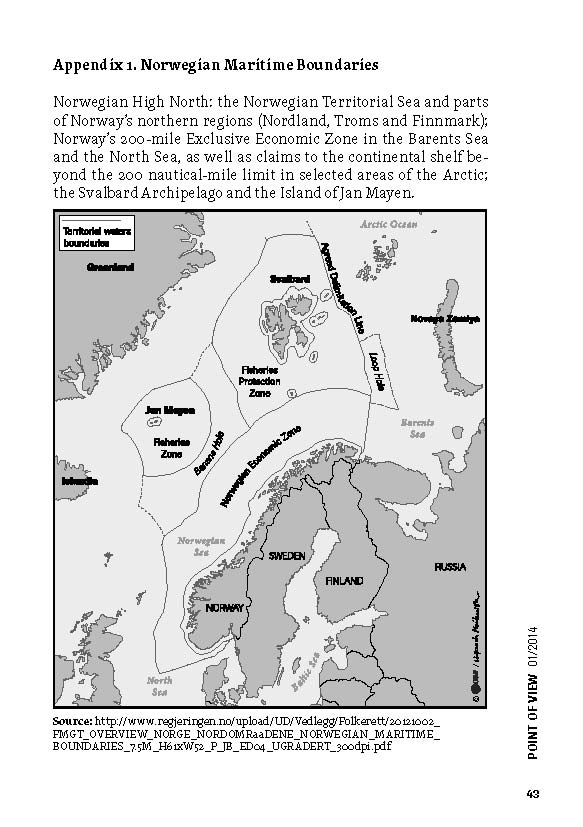
With the modernization of Russian forces, the addition of new surface and subsurface assets and enhanced precision strike capabilities, Norway and, indeed NATO, faces a formidable challenge, on both the conventional and nuclear level.
A key requirement is to have very accurate real time knowledge of the operation of Russian forces and sufficient capability to deal with those forces in times of crisis.
The Norwegians already have Aegis combat systems aboard their frigates which provides an opportunity to build out the fleet and to integrate them with the new air combat power coming to Norway and to NATO in the region.
Both the F-35s with their ability to have significant reach through the MADL linkages among the fleet and the ability to process data in real time, as well as the P-8 maritime domain awareness strike platform which can be cross linked among Norwegian, American and British platforms provides an important element of shaping a way ahead for the kind air-sea integration Norway needs to deal with evolving challenges.
During the Conference, one analyst focused on the bastion defense approach being taken by the Russians from the Kola Peninsula out and the challenges this posed for Norway.
The broad point is that not only are the Russians modernizing their forces they are working and extended reach for those forces from their own territories.
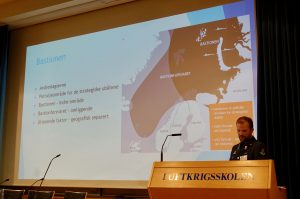 The Russian Bastion Defense Concept being discussed during the Norwegian Airpower Conference, February 2017
The Russian Bastion Defense Concept being discussed during the Norwegian Airpower Conference, February 2017
This was point made as well in an interview we did with the recently tired head of NORAD/NORTHCOM who highlighted the enhanced threat from the 10 and 2 Oclock from the United States and, of course, Norway lies in the 2:00 region as seen from North America.
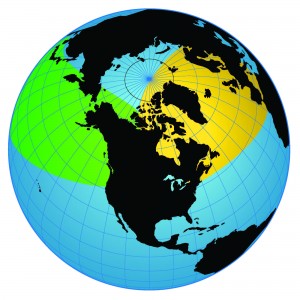 This is a notional rendering of the 10 and 2 O’Clock challenge. It is credited to Second Line of Defense and not in any way an official rendering by any agency of the US government. It is meant for illustration purposes only.
This is a notional rendering of the 10 and 2 O’Clock challenge. It is credited to Second Line of Defense and not in any way an official rendering by any agency of the US government. It is meant for illustration purposes only.
The head of the Norwegian Navy highlighted the importance of the new air platforms, and the new submarines and the need to effectively integrate the data provided by those platforms as well as crafting and evolving the C2 necessary to leverage an integrated air-sea force.
He also highlighted the fact that the sensors and weapons onboard his surface ships can interact with the air assets to provide support and protection as well for the air systems.
I asked him about the opportunity notably to integrate Aegis with F-35s, something I referred to in earlier work as the long-reach of Aegis, and he commented” that was more than happy to be the wingman for the F-35 if it helped destroy adversary targets.”
http://www.usni.org/magazines/proceedings/2012-01/long-reach-aegis
But he noted that this was a work in progress for the USN and the Norwegian Navy would work closely with the US Navy on this issue.
The Rear Admiral underscored that flying the same assets as the US Navy, the USAF and the RAF and the Royal Navy would provide enhanced capabilities within the North Atlantic.
And it should be noted that the coming of the Queen Elizabeth will bring F-35s into the integration effort with P-8s, and as Royal Navy Officer pointed out in his presentation in Australia to the air-sea integration conference, that the Royal Navy was looking to integrate their surface fleet with the F-35s to provide for cross cutting fire support, similar to what the US and Norwegian navies are looking to do as well.
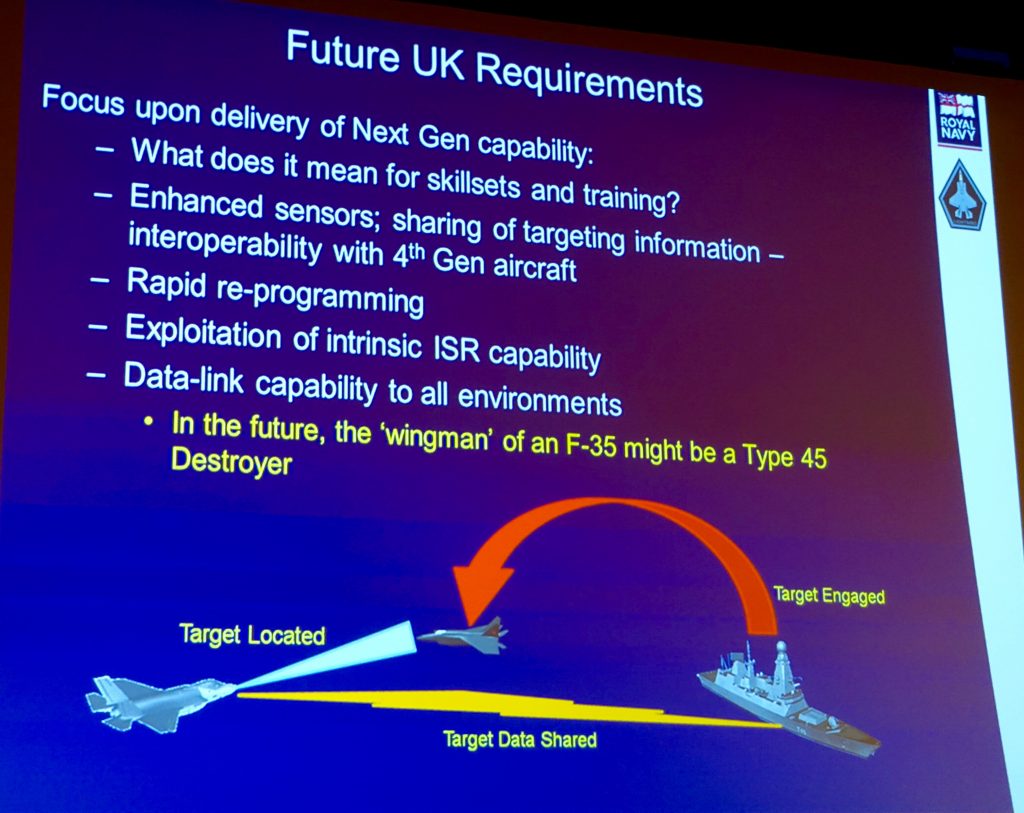
https://sldinfo.com/f-35-and-aegis-preparing-for-the-integrated-fight-in-the-extended-battlespace/
The Rear Admiral noted that the Norwegians have never stopped flying their MPAs, in this case their P-3s, over their areas of interest in the North.
They did not send their P-3s to the Middle East, nor did they retire their MPAs as did the UK.
“We have kept this competence not only alive but focused on the key areas of interest to us in the region.”
The P-3s have been “critical to understand the underwater domain for our forces. We are buying the P-8 because of its capability and the priority to focus upon this capability.
He argued that although they are interested in the future of autonomous systems, they will work with allied navies as they introduce such capabilities and to sort out a way ahead for Norway with regard to such systems in the future.
For example, in my recent interview with the USCG Commandant, he highlighted that he believed that Unmanned Underwater Vehicles might of interest, namely in the Arctic region.
I am sure the Norwegian Navy will watch this closely and interact with the USCG on their operational experiences as part of their own learning curve.
The Rear Admiral did point out that the P-8 and the F-35 are man-machine systems and as the Norwegian forces got operational experience with these systems, they would open the aperture with regard to expanding the scope of including autonomous systems as well.
Indeed, it should be noted that the USAF is working hard on fifth generation aircraft incorporating autonomous systems as part of future deployment packages (this is what Secretary Wynne has referred to as the Wolfpack operational concept).
https://sldinfo.com/shaping-the-wolfpack-leveraging-the-5th-generation-revolution/
The Rear Admiral closed by highlighting the challenge of shaping rapid decision making systems which can make effective use of the new systems.
In many ways his concern on this issue reminded of the comments by the Commander of the Australian Fleet:
“We are joint by necessity.
“Unlike the US Navy, we do not have our own air force or our own army. Joint is not a theological choice, it’s an operational necessity.”
It was clear both from his presentation and our discussion during the interview that Rear Admiral Mayer was focused on how the build out of the Navy in the period ahead would be highly correlated with the evolution of the joint network.
“The network is a weapons system.
“Lethality and survivability have to be realized through a networked effect.”
Editor’s Note: For a report from Australia on new approaches to air-sea integration, see the following:
https://sldinfo.com/new-approaches-to-air-sea-integration/
Editor’s Note: The slideshow earlier highlights Flotex 2016.
In these photos provided by the Norwegian Ministry of Defence, the Norwegian forces are viewed during the Flotex defense exercise held in the month of November.
Norway’s naval exercise Flotex might be the most beautiful of all military exercises, at least when it comes to surroundings.
The annual naval exercise is held every autumn.
Most of the Norwegian Navy’s capacities take part, including corvettes, support vessels, frigates and submarines.
In addition, rangers from the Coastal Ranger Command participate with their fast assault craft, Combat Boat 90.
The aim is to train all naval departments in planning and executing tactical operations at sea.
“Another aim is to build naval battle force, and to demonstrate visible and credible military presence in our northern seas”, says Head of Navy, Commodore Ole Morten Sandquist.
The Norwegian Navy spends about 40 per cent of its sailing hours in Northern Norway.
In an article published earlier this year, Norwegian officials are cited as looking for a revitalized NATO presence in the High North.
NATO has been called on to revitalise the notion of collective defence in the maritime domain by a senior Norwegian defence official. The move was suggested to offset what Ministry of Defence State Secretary Oystein Bo sees as strategic change in the nature of the maritime environment and the security risks therein.
Opening the UDT 2016 undersea defence and security conference and exhibition in Oslo on 1 June, Bo said that the need to revitalise the maritime leg of the collective defence concept was driven by the fact that “the strategic environment is changing [and] we are entering a new normal”.
He argued also that greater NATO presence is needed at sea in northern waters.
“Allied military peacetime activity in Norway and the North Atlantic remains an important part of a credible and robust policy. Therefore, we would definitely like to see a more frequent peacetime presence of allied forces in the High North and in the North Atlantic.”
For Norway, the development of the ‘new normal’ was evident in the High North, he said, noting that there are two sides to this development. On the one hand, he said, generating stability in the Arctic was a common interest that could form the basis for co-operation between the region’s stakeholders.
Norwegian and Russian maritime security agencies, for example, have long been co-operating on a number of low-level maritime security tasks including over-fishing, with the respective coastguards also co-operating to provide safety and security capacity for the benefit of both countries’ fishing communities.
In addition, the two countries have put in place a maritime delimitation agreement covering the Barents Sea and the Arctic Ocean, and a ‘hot line’ runs between Norway’s joint operational headquarters and the Russian Navy’s Northern Fleet.
Recently, Norway has announced that they are adding a P-8 acquisition to their coming F-35 force as part of their enhanced defense posture.
To provide for a maritime surveillance capability that can meet current and future challenges, the Norwegian Government has announced their intention to acquire five P-8A Poseidon maritime patrol aircraft for the Armed Forces,” the Norwegian Defense Ministry said in a statement attributed to Defence Minister Ine Eriksen Soreide.
“P-8A Poseidon is a formidable platform for monitoring our oceans, and will provide both Norwegian and allied civil and military authorities with a sound basis for decisions.
With modern sensors and weapons, the new Poseidon aircraft continue and improve this capability.”
The aircraft would replace Norway’s six Lockheed Martin-made P-3C Orion aircraft and three DA-20 Falcons, jets made by the French company Dassault.
The contract for the Poseidon aircraft also includes sensors, surveillance systems, anti-submarine weapons and support systems, according to the release.
This joins with the UK emphasis on the return to ASW and North Sea defense efforts as well,
According to a story on the UK Ministry of Defence website, the UK and Norway have agreed on new cooperation on Maritime Patrol Aircraft.
With the coming of the P-8 to the RAF, the UK MoD is looking to ways to enhance its impact on defense in the North Sea and beyond.
Sir Michael, who visited Norway’s top military headquarters, close to the Arctic Circle on Thursday, announced that the UK and Norway would work closer on Maritime Patrol Aircraft cooperation, including in reducing costs and increasing operational effectiveness.
The UK announced that it would procure nine Boeing P8 MPA in last year’s Strategic Defence and Security Review.
The new capability, which will be based in Scotland, will allow for enhanced situational awareness in key areas such as the North Atlantic, and will also further increase the protection of the UK’s nuclear deterrent and our two new aircraft carriers.
Sir Michael also visited Norway’s Bodø Main Air Station, home of two F-16 squadrons and a squadron of Search and Rescue Sea King helicopters, where he signed a new agreement on host nation support for UK exercises in the country, further increasing the UK and Norway’s ability to exercise, train and operate together.
Mr Fallon welcomed the fact that British armed forces undertake yearly winter training in Norway, particularly 3 Commando Brigade in Harstad and Evenes and elements of Joint Helicopter Command at Bardufoss.
Defence Secretary Sir Michael Fallon said:
Britain needs Maritime Patrol Aircraft to keep watch over the seas.
As part of our £178 billion defence equipment programme, we’ve committed to new maritime patrol aircraft that are able to monitor threats to Britain and our armed forces.
By stepping up cooperation with Norway on maritime patrol, we will help keep Britain safer and more secure.
The Defence Secretary arrived in Norway following meetings with the Northern Group countries on Wednesday in Copenhagen, where he reaffirmed the UK’s commitment to European defence.
As part of this, the Defence Secretary announced that 5 Battalion The Rifles would lead the UK’s battalion in Estonia next year, part of NATO’s Enhanced Forward Presence in the East.
Work on the UK’s MPA programme is progressing well, including the investment on infrastructure in Lossiemouth in Scotland, where the planes will be based.
Former armed forces personnel who previously served on UK Nimrod are also re-joining the RAF to help operate the future P-8s.
12 have recently re-joined and more will re-join in the future
https://www.gov.uk/government/news/uk-and-norway-agree-new-cooperation-on-maritime-patrol-aircraft

